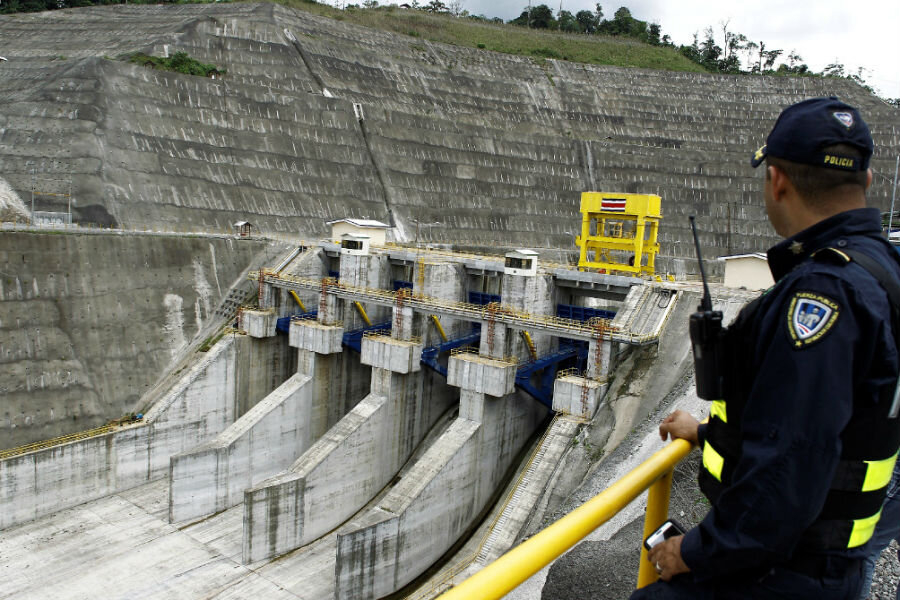Dam reservoirs linked to methane emissions: How dirty is 'clean' hydropower?
Loading...
Is hydropower less clean than it seems? A new study synthesizing prior research on water reservoir emissions suggests that they may emit the equivalent of a billion tons of carbon dioxide every year. That’s 1.3 percent of total global emissions.
The study, which will appear in next week’s BioScience, is the work of 10 authors at universities and institutions in the US, Canada, China, Brazil, and the Netherlands. They argue that reservoir emissions should be included in global carbon budgets, which they currently are not.
Many nations, particularly in the developing world, depend on hydropower as an affordable source of energy – and a way to meet Paris Accord commitments. If these findings are borne out by further research, they could affect international climate policy.
Hydropower has historically had proponents and detractors on both sides of the environmental debate. Some point to water-powered turbines as clean and renewable energy, while others criticize the dams and reservoirs that can destroy river ecosystems and displace millions of people.
At the Paris Climate Change Conference in December, more than 300 organizations called for large hydropower to be excluded from climate initiatives.
Prospects seem to be improving for dammed rivers, as The Christian Science Monitor’s Cristina Maza reported in May:
The Nature Conservancy has collaborated with the Army Corps of Engineers to reduce the impact of the dams already in existence. Their aim is to lower the impacts hydropower has on the environment by changing the way dams operate, helping to restore downstream ecosystems, and removing dams in places that have aging infrastructure that can’t be rehabilitated.
At one-sixth of the energy mix, hydropower is the world's leading source of renewable power — and another 3,700 dams are being planned or constructed worldwide. So the finding that acre for acre, reservoirs produce 25 percent more methane than previously thought is an important one for the future of the industry and for plans to curb carbon emissions.
What causes a reservoir to emit greenhouse gases?
The study’s authors have a provocative new answer. Where older studies had suggested tropical reservoirs were the biggest emitters, the new study finds that the culprits are the plants growing in reservoirs, regardless of latitude.
“We were surprised to find that the biological productivity of the reservoir (i.e. how many 'nutrients' like nitrogen and phosphorus the reservoir receives and the associated degree of algae growth) is a better predictor of emissions than is latitude. So, the most biologically productive reservoirs are producing the most methane,” writes Bridget Deemer, the study’s first author, in an email to The Christian Science Monitor.
The study authors suggest that Amazonian reservoirs do not emit significantly more methane than non-Amazonian reservoirs, a finding that runs counter to previous work on the topic, she adds.
Methane emissions are particularly high for recently constructed dams. As new reservoirs fill with water, the dams submerge plant and animal life, causing them to decompose and release methane.
Many developing nations consider damming rivers an easy and affordable source of power. Instead, says Astrid Puentes Riaño, co-executive director of the Interamerican Association for Environmental Defense, countries should meet their needs through a judicious combination of wind, solar, and geothermal power, as well as energy efficiency measures.
AIDA is helping to inform countries about what they believe the negative effects of hydropower are, and helping countries find better solutions, she tells the Monitor.
Particularly in Latin America, “countries are not really looking at [the] best solutions for energy,” she says, but choosing large hydropower installations almost by default. A large part of the solution is finding funds for “small-scale projects that are more community managed,” she adds.
But other renewable sources also have their detractors. A power outage in South Australia on Wednesday fueled concerns that solar and wind power are untrustworthy.
“The increasing percentage of power generation from intermittent sources such as solar and wind creates large fluctuations in voltage and frequency, challenging the system,” wrote The Australian on Thursday.
What long-term effect will the study will have on environmental policy?
Study co-author John Harrison, an associate professor at Washington State University’s School of the Environment, says he is working to update how the UN Environment Program calculates greenhouse gas emissions on the basis of these findings. But more research is needed to compare emissions from dams to those from traditional fuels.
In the meantime, hydropower remains an attractive option for many countries. Water is one of the few resources available to nations like Kyrgyzstan, one of the poorest countries in Central Asia. In the winter, when hydropower is not an option, the small nation relies on oil and gas from neighboring Kazakhstan, leading to energy shortages. The study’s findings, if integrated into international policy, could have a significant impact on Kyrgyzstan’s ability to meet its climate commitments – and on the country’s bottom line.
For now, the researchers’ focus is on information.
“We’re trying to provide policymakers and the public with a more complete picture of the consequences of damming a river,” Professor Harrison told The Washington Post.








